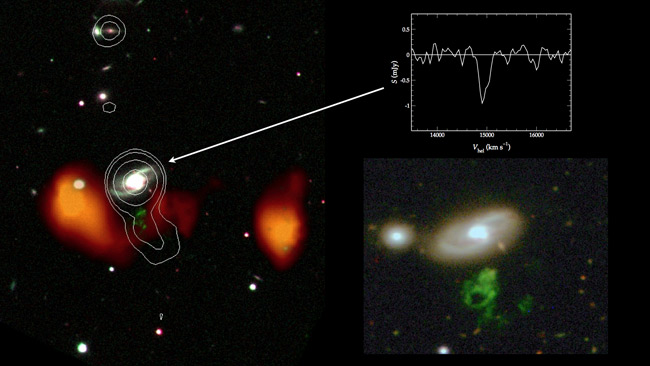Eerie Green Space Cloud Explained

An eerie green cloud lurking arounda nearby galaxy has puzzled scientists since it was discovered last year. Newobservations reveal that the cloud's ghoulish appearance may have to do withradiation streaming from a black hole inside the galaxy.
The cloud was first discovered byDutch schoolteacher Hanny van Arkel, who volunteered to sift throughastronomical data as part of the Galaxy Zoo project. Van Arkel came across animage of a huge, irregular-shaped greenish-yellowish cloud near the spiralgalaxy IC2497. The unusual object became known as "Hanny's Voorwerp,"Dutch for "Hanny's thing."
The cloud itself is devoid of stars,so astronomers were unsure what was generating the green glow. Some suggestedthat radiation from amassive black hole in the center of the galaxy (called a quasar) could bethe culprit, but until now no such black hole radiation had been visible.
"People had looked with X-raytelescopes and had not detected any quasar or black hole activity," saidresearcher Tom Oosterloo, an astronomer at the Netherlands Institute for RadioAstronomy. "But our new observations, in very high resolution, show thatthere is some activity. It's not spectacularly strong, but there is an activeblack hole."
Oosterloo and colleagues, led byMike Garrett of the Netherlands Institute for Radio Astronomy and including vanArkel, used the Westerbork Synthesis Radio Telescope in the Netherlands and an array in the European Very Long Baseline Interferometry Network toobserve Hanny's Voorwerp and IC2497.
The team found that a jet of highlyenergetic particles was indeed emanating from the galaxy, pointing directly atthe Voorwerp. Because the jet was not directed toward Earth, it was difficultto detect.
The researchers think particles inthis jet clear a path through the dense gas and dust around the galaxy,allowing radiation from the black hole to pour into a gas cloud partiallyencircling the galaxy. The optical and ultraviolet emission from the black holeexcites particles in the gas cloud, which is mostly made of hydrogen with someoxygen and other elements. The heated-up gas emits the greenish light we see.
Get the Space.com Newsletter
Breaking space news, the latest updates on rocket launches, skywatching events and more!
"In a way it's a cosmicaccident," Oosterloo told SPACE.com. "This black hole activityhappens a lot, and many galaxies havethis cloud, but it happens very rarely that the black hole jet hits thecloud. It's not the only such object known, but it's quite an interestingcase."
The gas cloud around the spiralgalaxy likely came to be when a smaller galaxy flew by IC2497. The largergalaxy's gravitation pull would have tugged off some of the other's gas,keeping a blanket of material near it long after the smaller galaxy had movedaway.
Van Arkel said she was happy to havegained new understanding of her voorwerp. "I'm happy we are makingprogress," she said. "Apparently the more we learn about theVoorwerp, the more intriguing it becomes."
- Video:Black Hole Blazar Jets
- ClosestLook Yet at Milky Way's Black Hole
- Video:Black Holes - Warping Time & Space
Join our Space Forums to keep talking space on the latest missions, night sky and more! And if you have a news tip, correction or comment, let us know at: community@space.com.

Clara Moskowitz is a science and space writer who joined the Space.com team in 2008 and served as Assistant Managing Editor from 2011 to 2013. Clara has a bachelor's degree in astronomy and physics from Wesleyan University, and a graduate certificate in science writing from the University of California, Santa Cruz. She covers everything from astronomy to human spaceflight and once aced a NASTAR suborbital spaceflight training program for space missions. Clara is currently Associate Editor of Scientific American. To see her latest project is, follow Clara on Twitter.









